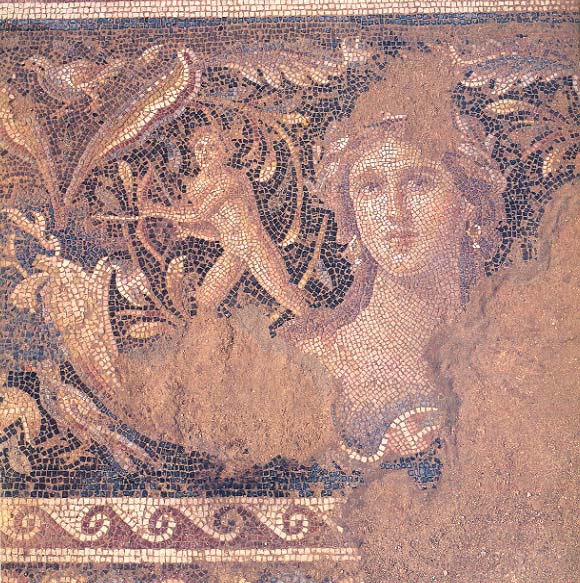“The Mona Lisa of the Galilee”
Set in the white ground of the mosaic floor at one end—like a beautiful rug—is a 20- by 20-foot area of colored mosaic. The colored area consists of a rectangle flanked along part of its length on two sides by panels illustrating processions. The processional on one side (bottom right foreground of the picture below) is quite intact, depicting people carrying agricultural produce. The large rectangular section of the mosaic includes three center panels surrounded by 12 rectangles, probably representing scenes from the life of Dionysus, the Greek god of wine and revelry. Each of the separate scenes is labeled with a Greek inscription. The scenes include Dionysus engaged in a drinking competition with Hercules, the marriage of the god, and a number of scenes showing Dionysus with Pan, god of music and shepherds.
A border of medallions formed by trailing acanthus leaves surrounds the 15 panels. Within most of the medallions appear animals in hunting or fighting scenes.
In one of the medallions, centered at one end of the rectangular “carpet,” is the most exquisite feature of the mosaic—an elegant, delicately shaded portrait of a woman crowned with a wreath. The captivating woman, who graces the cover of this issue, was once matched on the opposite side by another portrait—now destroyed.
The quality of the mosaic woman is extremely high, as reflected in the tiny stone tessarae (4–5 mm square) in a wide range of natural stone colors. Using these colored stones, the mosaic artist portrayed subtle variations between her bright earrings, the trim on her garment, the sheen on her lips, and the flush on her cheeks.
Approximately 15 percent intact, the floor was discovered in a remarkably well-preserved building with walls standing as high as six feet in some places and with some plastered surfaces decorated with frescoes.
Sepphoris was probably destroyed by an earthquake in 363 A.D. The mosaic floor was protected because it was in a building built into a hill. As a result of the earthquake, the mosaic was buried and left undisturbed beneath the rubble that fell from above. The building, originally two stories high, possibly served as the governor’s palace or residence. The room with the mosaic was probably a banquet room, or triclinium, where diners reclined on couches around the mosaic floor.
Sepphoris—the chief city of the region from about the first century B.C. to the fifth century A.D.—was a mixed community of pagan Romans, Christians and Jews. Important as a Jewish spiritual center, Sepphoris was the home of Rabbi Judah the Prince (Judah Hanasi), patriarch and leader of the Sanhedrin, the central body of Jewish legal and spiritual authority during Roman times. It was in Sepphoris that Rabbi Judah compiled the Mishnaha in about 200 A.D.
Archaeological evidence of the close relations between Jews and Romans at Sepphoris in the third century is the proximity of contemporaneous Jewish structures to the palace containing the Dionysus mosaic. This closeness is also suggested by a talmudic legend—actually from a Babylonian folktale—that tells of an unidentified Roman emperor who was so smitten with the wisdom of Rabbi Judah Hanasi that he exclaimed, “Would that I served as a mattress for thee in the world to come.”
